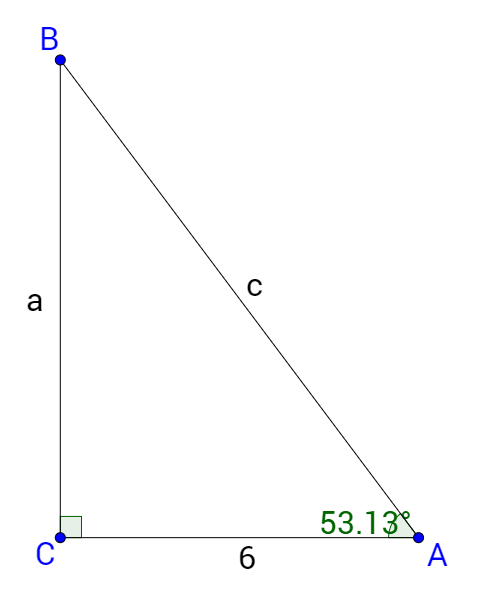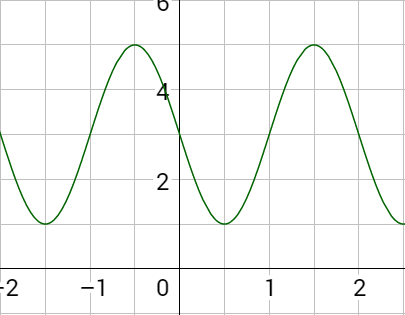Precalculus by Richard Wright
Precalculus by Richard Wright
Whoever sows to please their flesh, from the flesh will reap destruction; whoever sows to please the Spirit, from the Spirit will reap eternal life. Galatians 6:8 NIV
Summary: In this section, you will:
SDA NAD Content Standards (2018): PC.7.1, PC.7.3

The path of a cargo ship can be described using a distance and direction. The direction is called a bearing which can be calculated with trigonometric functions.
A direction such as E 30° N means 30° measured from the east going northward.
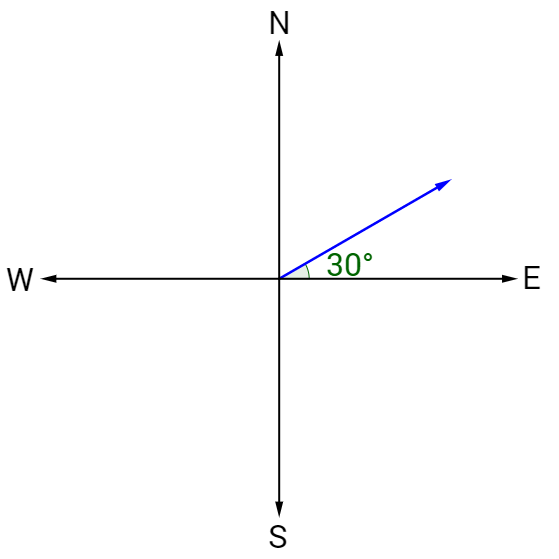
Solve bearing problems by drawing the picture and adding right triangles for each bearing.
A cargo ship leaves port and heads east at 10 knots (nautical miles per hour) for 1 hour. Then it turns and travels at 15 knots for 0.5 hours at E 40° S. What is the ship's current bearing from port?
Solution
Start by calculating the distances from the speeds and times.
East distance
d = rt
d = (10 knots)(1 hr) = 10 nautical miles
South of east distance
d = rt
d = (15 knots)(0.5 hr) = 7.5 nautical miles
Draw a picture and make right triangles for the bearings.
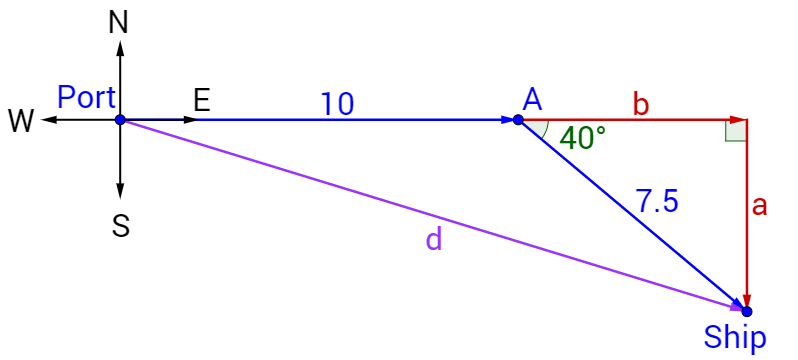
Start by finding the sides of the right triangle.
\(\sin 40° = \frac{a}{7.5\textrm{ mi}}\)
a = 7.5 mi sin 40° ≈ 4.82 mi
\(\cos 40° = \frac{b}{7.5\textrm{ mi}}\)
b = 7.5 mi cos 40° ≈ 5.74 mi
Add the lengths to find the sides of the large right triangle.
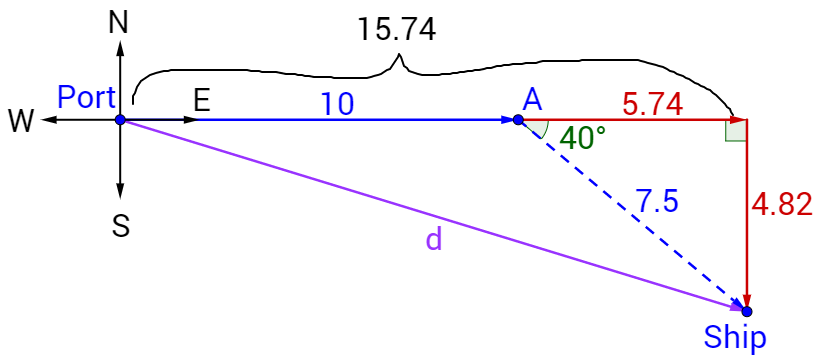
Use the Pythagorean theorem to find the hypotenuse of the triangle which is the distance from the port.
\(d = \sqrt{x^2 + y^2}\)
\(d = \sqrt{\left(15.74\textrm{ mi}\right)^2 + \left(4.82\textrm{ mi}\right)^2} ≈ 16.5\textrm{ mi}\)
Use tangent to find the direction angle.
\(\tan θ = \frac{y}{x}\)
\(\tan θ = \frac{4.82}{15.74}\)
\(θ = \tan^{–1} \frac{4.82}{15.74} ≈ 17.0°\)
The ship is about 16.5 miles at E 17.0° S from port.
A Pathfinder is walking through the woods using a compass to find his way. He walked 1 mile due north then turned and walked 2 miles at N 30° E. What distance and direction does he need to walk to return to his starting point?
Answer
2.91 miles at N 20.1° E
Motion that is repeated such as a swinging pendulum can be modeled with sine or cosine. Consider a weight bouncing on the end of a spring. At time t = 0, the weight is in the center equilibrium position, y = 0. A short time later, t = 1, the weight is at the highest point, y = 2. Then at t = 2, the weight is back in the center, y = 0. Next at t = 3, the weight is at the lowest point, y = −2. Finally, at t = 4, the weight is back in the center equilibrium position. See figure 5. It is easy to sketch the sine curve so that it fits the position of the weight.
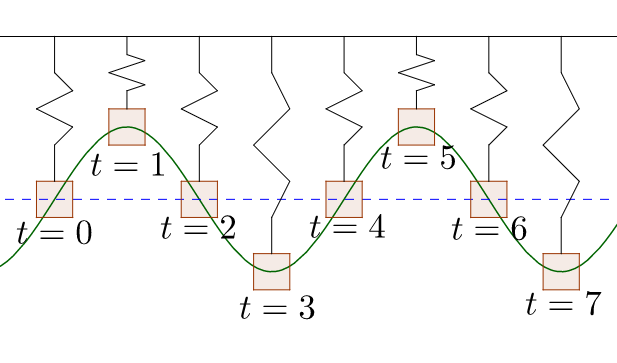
The initial position is y = 0, just like the y-value of sine is 0 at the origin. Remember the transformed sine function from lesson 4-06. The formula was y = a sin(bx – c) + d. a = amplitude, b comes from the period formula \(T = \frac{2π}{b}\), c comes from the phase shift \(PS = \frac{c}{b}\), and d is the vertical shift. This formula is simplified by assuming that there is no phase shift or vertical shift. The formulas for simple harmonic motion are
d = a sin ωt
d = a cos ωt
ω can be found from the period, \(T = \frac{2π}{ω}\), or frequency, \(f = \frac{ω}{2π}\).
A weight is bouncing on the end of a spring such that at time t = 0, the weight is at the lowest point, y = 5 cm below equilibrium. After 10 seconds, the weight is back at the lowest point. Write a model for the motion of the weight from equilibrium.
Solution
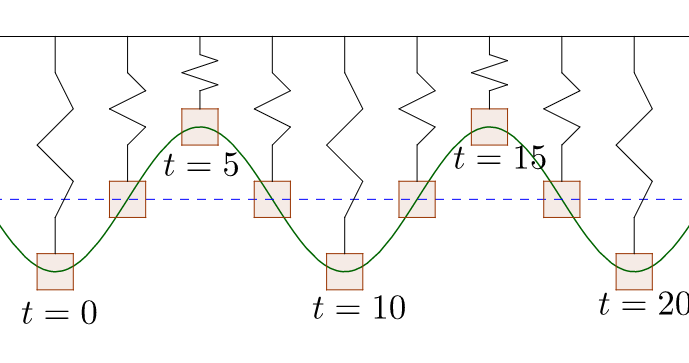
Since the weight starts at a minimum, use cosine. Since it starts at a minimum which is 5 cm below the center equilibrium, a = –5. Because the weight returns to the starting point after 10 seconds, the period is 10. Use it to find ω.
\(T = \frac{2π}{ω}\)
\(10 = \frac{2π}{ω}\)
\(ω = \frac{2π}{10} = \frac{π}{5}\)
Because the weight starts at a minimum or maximum, there is no phase shift so c = 0. Lastly, since the question is asking for motion from equilibrium, there is no vertical shift and d = 0.
The model is \(d = –5 \cos\left(\frac{π}{5}t\right)\).
A wave on a pond moves up and down with a frequency of 5 Hz. If the maximum wave height is 2 cm, write a function to model the wave height.
Answer
d = 2 sin 10πt
Given the function for simple harmonic motion
\(d = 3 \sin\left(\frac{2π}{3}t\right)\)
Find a) maximum displacement, b) the frequency, c) the period, d) the value of d when t = 10, and e) the least positive value of t for which d = 0.
Solution
Compare \(d = 3 \sin\left(\frac{2π}{3}t\right)\) with d = a sin ωt.
a = 3
\(ω = \frac{2π}{3}\)
The frequency is found by \(f = \frac{ω}{2π}\).
\(f = \frac{2π/3}{2π} = \frac{1}{3}\)
The period is found by \(T = \frac{2π}{ω}\).
\(T = \frac{2π}{2π/3} = 3\)
To find the least positive value of t for which d = 0, solve
\(3 \sin\left(\frac{2π}{3} t\right) = 0\)
\(\sin\left(\frac{2π}{3} t\right) = 0\)
This is true when \(\left(\frac{2π}{3} t\right)\) = 0, π, 2π, 3π, …. Multiplying both sides by \(\frac{3}{2π}\) gives t = 0, \(\frac{3}{2}\), 3, \(\frac{9}{2}\), …. The smallest value is 0.
Given the function for simple harmonic motion
d = –4 cos πt
Find a) maximum displacement, b) the frequency, c) the period, d) the value of d when t = 10, and e) the least positive value of t for which d = 0.
Answer
4; \(\frac{1}{2}\); 2; –4; \(\frac{1}{2}\)
Helpful videos about this lesson.
